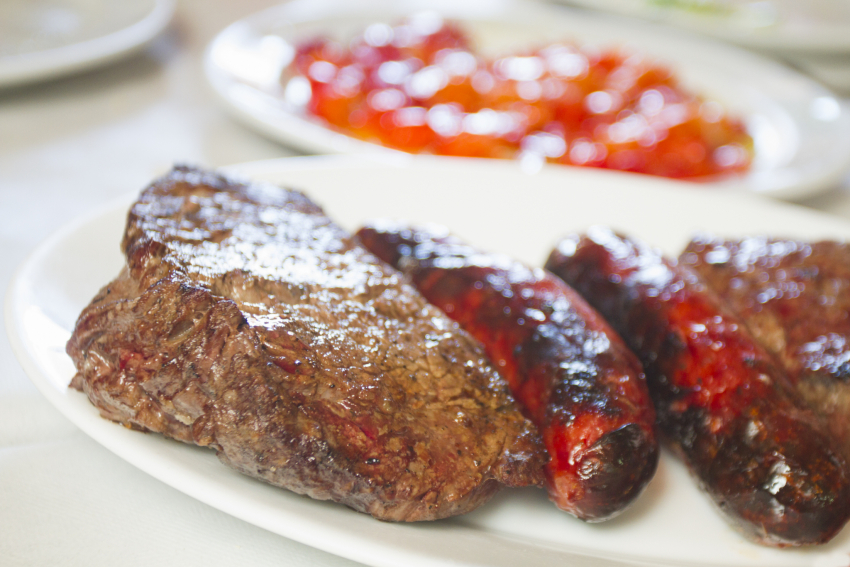Alex Bramwell
Which Gran Canaria Airport Transfer Service Is The Best?
There are three main types of Gran Canaria airport transfer services, each with its own benefits, risks and price point. Here's our guide to them all, and a shameless plug for the in-house transfer service that helps keep the lights on at Gran Canaria Info's headquarters.
Man from pub with car
The cheapest airport transfer service is the 'man (or woman) from the pub with a car' service. This is operated by a Gran Canaria resident who picks people up in their own car from the airport. They often advertise in pubs or run pubs in resort areas, and get customers by word of mouth. They don't advertise online or in public because this type of service is 'under the radar'.
With the man with car model you are basically paying cash in hand for someone pretending to be your friend to pick you up from the airport (or drop you back). As such they will be parked in the public car park rather than in the public transport zone next to arrivals.
Legal transfer cars have blue license plates, a VTC aand SB sticker in the window, and their own parking zone at the airport. A legitimate driver does not have to pay a parking fee. Read more about the differences between legal and illegal transfers here.
This airport transfer service is often the cheapest option because the bloke with car does not have to pay for advertising and often doesn't pay business rates, taxes or professional insurance from their takings. They are cheap because they cut corners.
We don't really support this model of airport transfer service for two reasons. The first is that we don't know if a particular man with car is insured and / or a safe driver. The second is that we have no idea whether he pays anything back into the local Gran Canaria economy. We do know that informal transfers undermine the local drivers and companies who do pay their taxes and business fees.
Imagine the scandal in Puerto Rico if taxi drivers started selling tax-free beer to tourists!
The big branded airport transfer services
These are the services like Hoppa, Viva, Sun, etc.
These airport transfer services have large advertising budgets and websites that offer transfers from any airport. You book, pay upfront and when you walk through into arrivals, there is a driver with a sign waiting for you. The booking service takes a big chunk in commission and pays the rest to the company that owns the car and pays the driver.
Services like Hoppa and Viva never actually own the car or employ the driver that you meet. Nor do they have a help desk, or even employ any staff on the island. Instead they are based offshore and the savings they make mean that they caan spend huge amounts on advertising. Then they keep asking for lower prices from the drivers as they gain market share. None of the money they take in commission stays in Gran Canaria or any of the other destinations they offer.
There is very little difference between these services because they all use the same local companies to do the actual driving. A licensed local driver will reach the airport and pick up the next passenger on their list without even knowing which website they booked with. The driver is paid and the car insured by the local transport company that owns the cars, not by the booking service.
That said, all big branded services tend to be reasonably priced and are quite reliable. However, if something does go wrong there is nobody on the ground to sort it out. If a big transfer service drops the ball, then you are likely to be on your own, or at least face a long delay until someone at the call centre works out what happened.
Local Gran Canaria airport transfer services
 The transport companies that operate the cars and pay the drivers that do Gran Canaria airport transfers do take direct bookings. However they also work with local transfer services to handle international bookings. It is easier and just as economical for them to pay commission as it is to take bookings themselves.
The transport companies that operate the cars and pay the drivers that do Gran Canaria airport transfers do take direct bookings. However they also work with local transfer services to handle international bookings. It is easier and just as economical for them to pay commission as it is to take bookings themselves.
This is what we do at Gran Canaria Info. We work with exactly the same drivers and cars as all the branded transfer services. However, the commission we keep is much smaller than the wedge that big services pocket. The commission we earn for handling the booking helps us to keep improving Gran Canaria Info.
Gran Canaria Info's airport transfer service is reliable, fairly priced and is all operated from Gran Canaria. This means that if something does go wrong (delays, traffic, breakdowns) we are here to sort things out as quickly as possible.
What about buses and taxis at Gran Canaria airport?
The local Gran Canaria bus network is decent and you rarely have to wait more than half an hour before hopping on a bus to the main resorts or to Las Palmas. Just follow the bus stop signs at arrivals, then check Google maps for the next bus to your destination. Then take a taxi from the bus stop or station closest to your accommodation. For one person, or a couple, using the buses saves money but once there are three of you or more, a taxi or transfer often works out cheaper.
Taxis queue right outside the arrivals lounge at Gran Canaria airport. They are reasonably priced and you can normally just walk over and get one right away. However, there can be queues at peak times and prices rise late at night, on fiesta days and on Sundays. There is a limited supply of large taxis so if your group is bigger than four (three if the Covid Levels go up), then it is better to book a large vehicle with a local Gran Canaria transfer service. A transfer is always cheaper than using two taxis, and transfers are cheaper than the standard taxi meter rate for resorts like Mogán and Puerto Rico that are further from the airport.
So, there you have it. The facts about Gran Canaria airport transfers. Obviously we'd love you to use our own reliable service, or to book an excursion or boat trip with us but the decision, like the holiday, is all yours. Thank you for visiting Gran Canaria Info and we hope to see you in our Gran Canaria Info Facebook Group soon.
If you want to book the Gran Canaria Info airport transfer service, or a transfer back to the airport, you can do it here. Our service is reliable and well-priced and using it helps us keep the lights on at GCI headquarters.
Amazing Things Made From Lava Flows In The Canary Islands
Teide volcano was belching ash when Columbus sailed past on his way to accidentally discovering America in 1492, and a large chunk of Lanzarote got covered in lava during the 1730s. More recently, El Hierro experienced an undersea eruption off its southern tip in 2011 and La Palma island is currently experiencing an eruption on its southwestern flank.
Volcanic activity can be violent and destructive with houses and farms swallowed by lava and ash. However, volcanoes are also the reason the Canary Islands exist and without fresh lava, the archipelago will one day disappear back under the sea.
And since eruptions have been an inevitable part of live on the Canary Islands since people arrived here, the locals know how to take advantage of the lava once it cools. Here are some of the ways Canarians have made amazing things out of lava flows.
Natural swimming pools made from lava
 When molten rock hits the sea it forms a rock delta or fajana that sticks out into the sea. In many cases they form natural pools because the lava shrinks as it cools, or blocks off an area of the old coastline. The nartual pools at Agaete in Gran Canaria, called Las Salinas, are a great example of this. Pozo de las Calcosas pool in El Hierro is another. And La Fajana in La Palma is yet another.
When molten rock hits the sea it forms a rock delta or fajana that sticks out into the sea. In many cases they form natural pools because the lava shrinks as it cools, or blocks off an area of the old coastline. The nartual pools at Agaete in Gran Canaria, called Las Salinas, are a great example of this. Pozo de las Calcosas pool in El Hierro is another. And La Fajana in La Palma is yet another.
Lava Cemeteries In Gran Canaria
 Gran Canaria's aboriginal people, called the Canarii, buried their dead in side lava flows at burial sites like Maipez in the Agaete Valley. Nobody knows whether they did it as an offerring to the mountains that they considered sacred or whether it was just a convenient place to put their dead. Either way, they chosse the solid lava rivers of Gran Canaria as the place for their cemeteries.
Gran Canaria's aboriginal people, called the Canarii, buried their dead in side lava flows at burial sites like Maipez in the Agaete Valley. Nobody knows whether they did it as an offerring to the mountains that they considered sacred or whether it was just a convenient place to put their dead. Either way, they chosse the solid lava rivers of Gran Canaria as the place for their cemeteries.
Lava banana plantations in La Palma
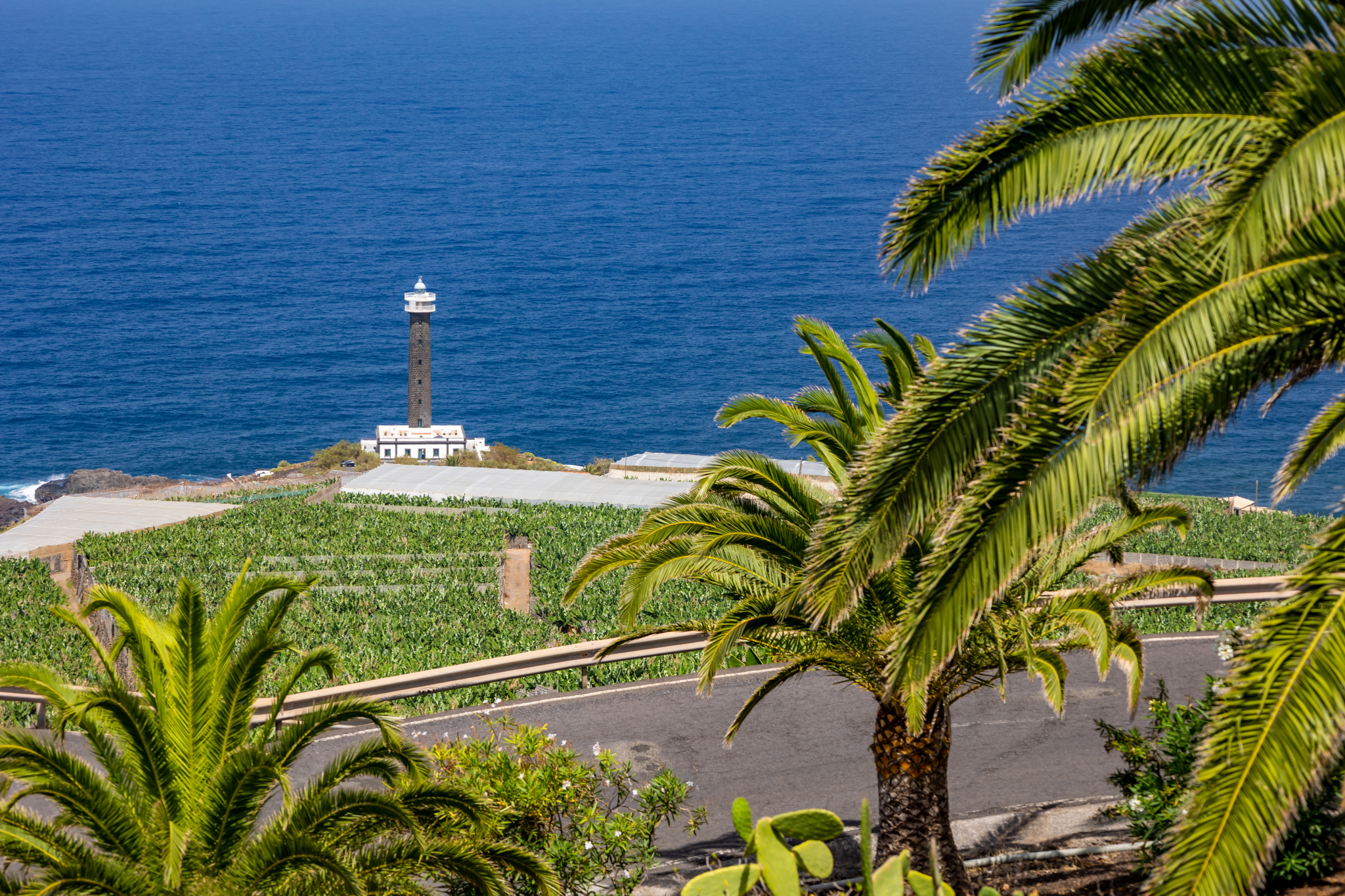 When La Palma erupted in 1949, the lave destroyed banana plantations as it flowed towards the sea. It then formed a large delta just to the south of the current volcanic activity. As soon as it was cool, La Palma locals started to bring soil from up in the highlands and put it on top of the lava. The area is now one of the most productive banana plantations in the Canary Islands. In Fuencaliente, at the far southern tip of La Palma, there is now a large, multicoloured saltpan on top of the lava from from the 1971 eruption.
When La Palma erupted in 1949, the lave destroyed banana plantations as it flowed towards the sea. It then formed a large delta just to the south of the current volcanic activity. As soon as it was cool, La Palma locals started to bring soil from up in the highlands and put it on top of the lava. The area is now one of the most productive banana plantations in the Canary Islands. In Fuencaliente, at the far southern tip of La Palma, there is now a large, multicoloured saltpan on top of the lava from from the 1971 eruption.
Auditoriums made out of lava tubes in Lanzarote
 As lava flows the surface cools and solidifies. The molten lava keeps flowing thjough within a rock tunnel. When the volcano stops it leaves behind long tunnels that were once underground rivers of lava. In Lanzarote, local artist Cesar Manrique took these lava tubes and made one into an Auditorium and garden at Los Jameos de Agua , another into a tourist attraction called the Cueva de los Verdes. He even built his house on top of a lava tube, put a swimming pool inside it, and had a lava flow inside his living room!
As lava flows the surface cools and solidifies. The molten lava keeps flowing thjough within a rock tunnel. When the volcano stops it leaves behind long tunnels that were once underground rivers of lava. In Lanzarote, local artist Cesar Manrique took these lava tubes and made one into an Auditorium and garden at Los Jameos de Agua , another into a tourist attraction called the Cueva de los Verdes. He even built his house on top of a lava tube, put a swimming pool inside it, and had a lava flow inside his living room!
Lava flows as walks and tourist attractions
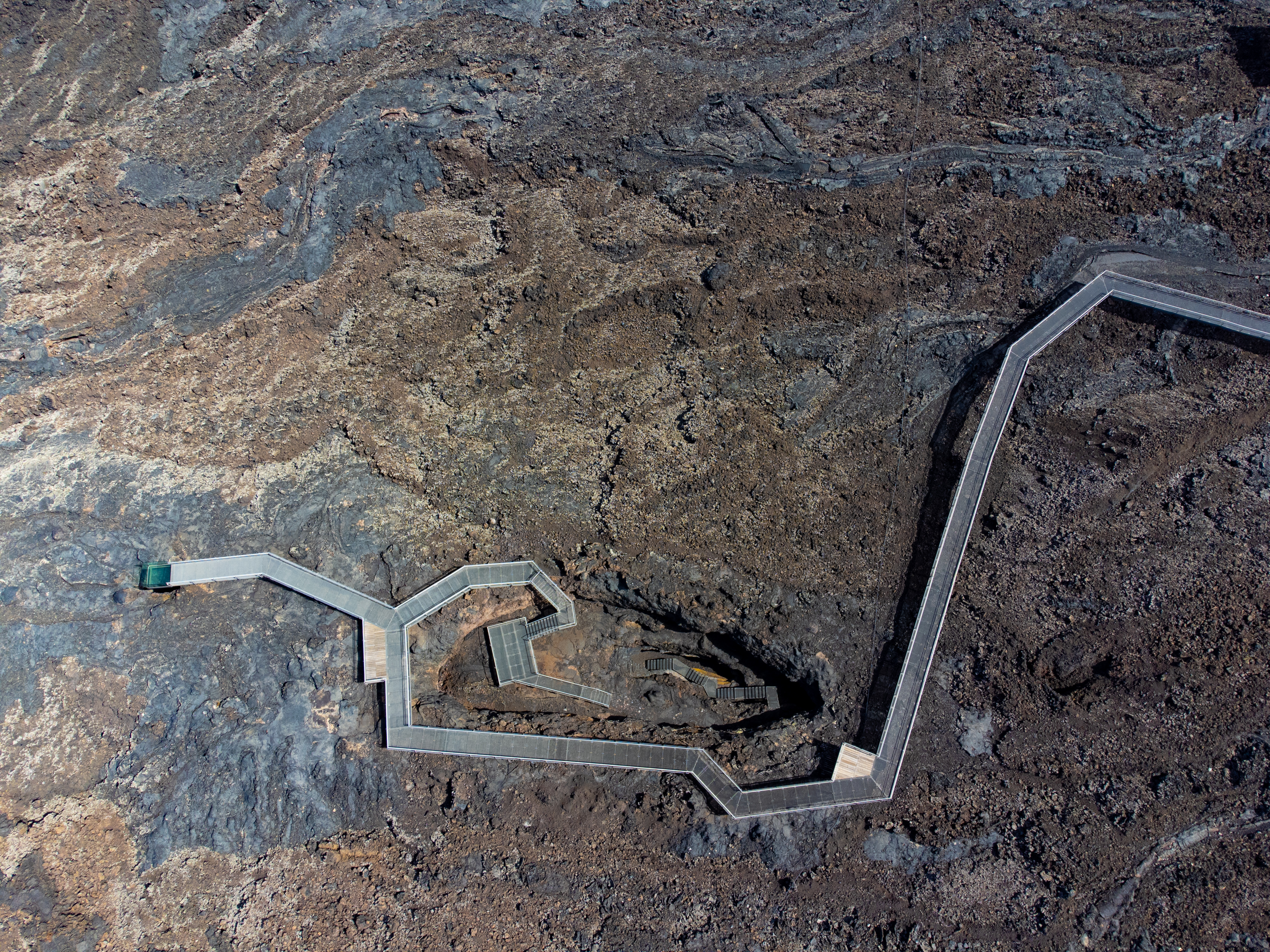 In La Palma, the Caños de Fuego visitor centre lets you walk over the lava flow from the 1949 eruption of the San Juan volcano, then drop down from the boardwalk into caves and tunnels left by the flowing lava as the volcano stopped.
In La Palma, the Caños de Fuego visitor centre lets you walk over the lava flow from the 1949 eruption of the San Juan volcano, then drop down from the boardwalk into caves and tunnels left by the flowing lava as the volcano stopped.
Barbeques using volcanic heat
 At Timanfaya in Lanzarote the ground is still so hot after the 1730 eruption that the restaurant cooks its food over an open pit. Around the back (ask the geyser man where it is) there are even a couple of barbeques that visitors to the Timanfaya National Park can use to grill their lunch.
At Timanfaya in Lanzarote the ground is still so hot after the 1730 eruption that the restaurant cooks its food over an open pit. Around the back (ask the geyser man where it is) there are even a couple of barbeques that visitors to the Timanfaya National Park can use to grill their lunch.
Vineyards on on the lava rock
 A thick layer of lava covered large areas of Lanzarote during the last eruptions on the island. Volcanic gravel, called lapili or picon, covered an ever bigger part of the island. This bubbly rock, formed from lava foam, traps moisture from the cool night air and keeps the soil buried metres underneath moist all-year-round. Lanzarote locals worked out almost as soon as the ground had cooled that they could dig down to the soil and grow crops and grape vines. Some of the vines they planted are still in their original holes almost 300 years later.
A thick layer of lava covered large areas of Lanzarote during the last eruptions on the island. Volcanic gravel, called lapili or picon, covered an ever bigger part of the island. This bubbly rock, formed from lava foam, traps moisture from the cool night air and keeps the soil buried metres underneath moist all-year-round. Lanzarote locals worked out almost as soon as the ground had cooled that they could dig down to the soil and grow crops and grape vines. Some of the vines they planted are still in their original holes almost 300 years later.
Learn Spanish With A Local Teacher From La Casita De Laura In Las Palmas
Learning Spanish for a couple of hours is a fun holiday option that lets you experience what it really feels like to be Canarian, and have some real-life interactions with locals during your stay in paradise.
It is also essential if you plan to stay on the island(s) or travel to Spain for more than a getaway.
In this article you will:
- learn about “La Casita de Laura - Learn Spanish”, a successful language business based in Las Palmas de Gran Canaria (teaching Spanish to foreigners for over 8 years!),
- pick up some useful Spanish tips for when you are in the Canaries and...
- get to meet the young entrepreneur behind it all.

HOLA, Laura León! Could you share a bit about why did you decide to dedicate your life to teaching Spanish and helping newcomers integrate in the local language and Canarian culture?
I love traveling and learning languages myself (I speak English, Italian, French and understand a few other European languages), so it soon became very natural to also share my language and my culture with other travelers. That is why almost 9 years ago I decided to create “La Casita de Laura – Learn Spanish”, to help newcomers integrate in the community and learn more about the locals, our way of living life and enjoying its simple things.

How easy is learning Spanish at La Casita? What can people expect when learning Spanish with you?
Imagine if you could learn Spanish with your best friend. Well, what we offer is exactly that! We are three freelance teachers working under the same brand name. What we do is we become our students friends and we guide them through the process of learning Spanish with a very conversational method and lots of practice. We keep it very simple and more importantly FUN, so our students don’t frustrated with all the boring grammar. Anyone joining our community can expect very little weekly commitment and a great progress. You just need to read our reviews and see how many students tend to extend their programs, to keep on learning and having fun with us.
So, you are teaching anyone who would like to learn Spanish? Do you only teach adults or also children?
We have had students from 5 up to 70 something years old. We do specialize in expat families and remote workers or digital nomads who need Spanish to live in the Canaries, but we also have many students who decide to come here on holidays and take Spanish to get to speak to locals and enjoy their experience to the max. I teach mainly adults but my colleague Niti is also really good with children. More recently, due to the COVID crisis we have focused more on the online teaching which has allowed us to get even students from abroad, people who would like to improve their Spanish and get ready for their next visit to a Spanish speaking city. For in-person lessons (whenever possible due to the restrictions), me and my colleague Niti we teach in Las Palmas and our other colleague, Dina, teaches in Maspalomas.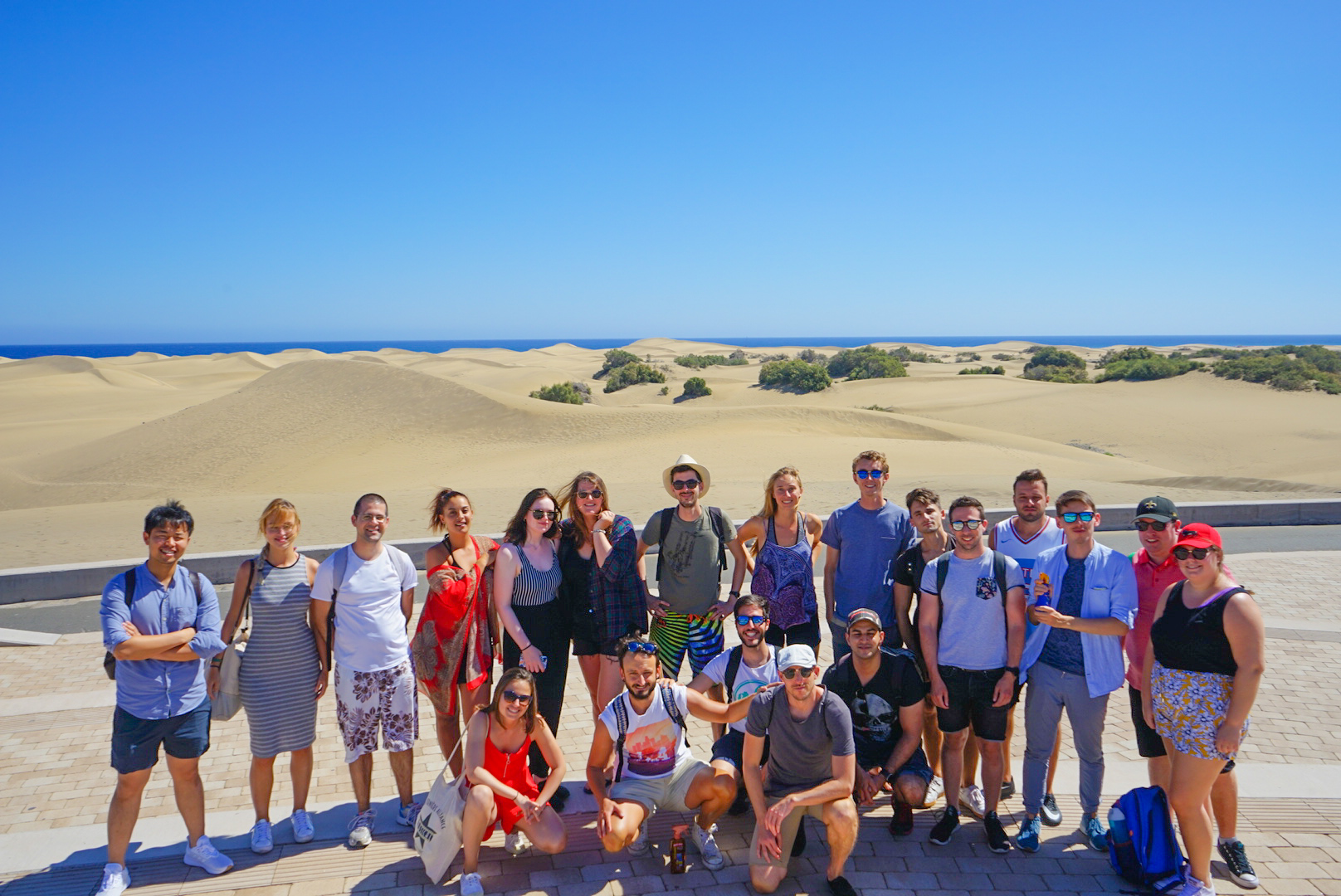
What would you say it is the common struggle of those who start learning Spanish?
They struggle with basic conversations in interactions with locals. They feel alone and lost in translation! Especially those who come to Gran Canaria to live with their Canarian partner - when they meet their new extended family they often feel like they can’t find the words to be able to interact in basic everyday life conversations. We focus on making that integration process faster and less painful. They find in our lessons a safe space for them to make mistakes (and not be judged), get proper corrections and grammar explanations when needed. It helps them regain some control in their lives. We connect with them because we understand what they are going through. It’s very rewarding seeing them grow confidence and become the most updated Spanish version of themselves. And they know they are not alone. We have created an amazing community and we do organize free Spanish meetups online and in-person ones whenever we can.
Could you share some Spanish tips for our readers to make it easier to understand Canarians?
Here you go, the top 5 Canarian Tips that will help you a lot:
1. Letter “-S” is kind of randomly exhaled mostly at the end of words, and it sounds almost like an English “h”, but for some reason tends to sound like an omission to foreign ears. One good example would be “gracias” which really sounds like “graseeah”, or ‘hasta luego’ which sounds like “ahta looegho”.
2. Canarians use “ustedes” instead of “vosotros” when addressing more than one person at the same time (“you all”). For example, we would say “¿Ustedes son de Reino Unido?” for ‘Are you all from the UK?’, instead of “¿Vosotros sois de Reino Unido?”. This actually happens also in most countries across Latin America, so we could say that “vosotros” is only used in the mainland, and even they may understand you if you use “ustedes” and not “vosotros”. Canarians can travel to the mainland and they never have any misunderstandings, they may just sound more formal – which is not a bad thing, right?
3. When Canarians use “mi niño/a” (my child), “mi cielo” (my sky), “mi amor” (my love) they are doing it from a good place as a term of endearment, don’t take it literally. They are not calling you “my child” or “my love”, they are just trying to be friendly and more approachable. Once you get used to it, you will miss it when you go back.
4. Canarians don’t use “Pasado Compuesto (Pretérito Perfecto Compuesto)”, they use “Indefinido (Pasado Simple)” instead. But I always encourage my students to use it because it’s easier to conjugate and we understand it anyway. For example, “Hoy fui a la playa” rather than “Hoy he ido a la playa”, to say that you went to the beach earlier that day.
5. We have a beautiful and very rich dialect and very funny words for some everyday things, for example “la guagua” for bus, “papa” for potato, “mojo” for our very own Canarian red or green spicy sauce, “millo” for corn, “leche y leche” for a delicious and extremely sweet coffee with condensed milk, “fleje” for when we want to say “a lot”, “calufa” for extreme heat and “chacho/a” for buddy/girl.
Thanks so much for sharing these useful tips and for your dedication to help newcomers in Gran Canaria. How can people connect with you?
They can find “La Casita de Laura – Learn Spanish” on Google, Facebook and Instagram, and also feel free to reach out via email to This email address is being protected from spambots. You need JavaScript enabled to view it. We are also working on our YouTube channel where we will be sharing tips and hacks to learn Spanish faster and easier.
So, if you would like to learn Spanish or improve it, head to “La Casita de Laura – Learn Spanish”; hands down the most fun and useful Spanish learning experience in Gran Canaria.
Canary Islands Cheese: A Quick Guide To The Best Stuff
Go to any market or even local supermarkets and you find piles of cheese made in the Canary Islands but not all of it is the real deal. Here's how you recognise the good stuff...
The best Gran Canaria and Canary Islands cheese is made from goat and sheep cheese although most of the cheese on sale in supermarkets is a blend of cow and goat or sheep cheese.
If a cheese has a picture of a cow on the label, you know it is a mixture. Or if it says 'mezcla de leche de cabra, oveja y VACA'. This doesn't mean that it won't be nice but it will be blander tasting and with a smoother texture than the proper stuff.
Types of Canary Islands cheese
There are well over 100 cheeseries on Gran Canaria, 500 across the islands, and Canarians love their cheese so much that they eat over 11kg per person every year.
Queso tierno is fresh cheese that hasn't had a chance to ripen. It is pure white and roughly equivalent to Mozarella. It's often served as a starter along with sweet quince or guava jelly, or in salads. Go for a brand like Pajonales (black tub) that is pure goat cheese and has some flavour because queso tierno can be bland.
Queso semi tierno is cheese that has had some maturing time in a cellar or cave. It's still creamy and soft but has developed some flavour and sharpness. Many Canarian cheeses have gofio or pimentón rubbed into the rind during then curing process.
Queso duro or maduro is mature cheese that has plenty of acidity and flavour. It can still be fairly soft but some go rock hard (great for grating over pasta or using to make pesto).
Queso flor is a sheep milk cheese made using thistle sap rather than rennet. It is soft and tastes of grass and socks; a real cheese-lovers cheese. The real stuff is just called flor but you often see semi-flor which uses some rennet and is harder and milder in flavour. Proper flor comes in small wheel only a few centimetres high because it doesn't hold its shape well enough to be bigger or taller. Flor de Guia cheese has its own EU designation of origin and has to be made mostly from local sheep milk fro sheep that roam free to graze. It was first mentioned in 1526!
Queso Majorero is cheese made from goat milk in Fuerteventura. It tends to be drier, spicier and more acidic with a stronger flavour than Gran Canaria cheeeses. Try the maduro or semi curado with the pimentón rind by the Maxorata brand. This is sold in local supermarkets and has won lots of medals at the World Cheese Awards.
Queso ahumado is smoked cheese and is traditionally made on El Hierro island.
Find the best cheese in Gran Canaria
Gran Canaria cheeses tend to be slightly sweet with bitter, herbal notes and small irregular holes. Many are made from raw goat and sheep milk which is quite safe because the Canary Islands are brucelosis-free.
A lot of the tastiest cheeses come from mountain areas like Valsequillo and Tejeda where the goats and sheep get to graze, or at least are fed with fodder harvested on the island.
Local markets are an excellent place to try and buy local cheeses as you always get a nibble before you have to choose. Don't be afraid to say what you like.
"Mas fuerte" means stronger while "mas suave" means milder.
Local shops and delis also allow tasting,as do some supermarket deli counters (although Covid has made this rarer).
No matter where you buy your cheese, try to keep it out of the fridge or at least let it warm up before you eat it. Refrigeration can change the texture of cheese, especially flor de Guía.
Canary Islands cheese for vegetarians
All Canary Islands cheese sold in shops and markets is made with vegetarian-friendly rennet and pure queso flor is made using thistle sap rather than rennet to curdle the milk.
Beachfront Tapas In Las Palmas: Toma Pan y Moja
Tapas are not a traditional thing in Gran Canaria. You don't get the free tapa with every beer that is so common in Mainland Spain, except on Tapas nights.
That said, there are places that offer something similar to the tapas experience in the capital Las Palmas.
Toma Pan y Moja, on ther beachfront at the southern tip of Playa Chica, is one of the best.
It has sunset views, outdoor tables (the ones furthest from the door get less breeze) for hot days and a cosy interior for those cooler winter evenings.
The papas con mojo with heirloom black Canary Islands potatoes are delicious (summer season only). The cold tomato soup (salmorejo) is very tasty, the croquetas excellent and the ham is decent quality. Try the tortilla española with avocado if you dare!
With friendly service, generous portions and fair prices, Toma Pan y Moja is always a good bet for a snack on the Las Canteras beachfront.
The Many Mojos And How to Majar Them
Red mojo or green mojo?
This is always the most answered question on our Facebook page and the red version is slightly more popular. This is probably because it comes on the papas arrugadas (wrinkly popes as they are sometimes translated on local menus). Somehow, red and green are the only two mojo variations that make it onto restaurant tables. But there is far more to mojo than a binary choice.
From red and green to almond and avocado
Almond mojo is made from garlic, pimentón and peeled almonds pounded with olive oil in a pestle ands mortar. In La Palma they add smoked cheese to green mojo, in El Hierro fresh cheese to red mojo. In La Gomera they add hard cheese to the mojo and and call it almogrote.
Then there's the superb but rarely made mojo de aguacate based on avocado, herbs, green chili and cumin. Even with the standard red and green versions, every family has their own mojo recipes.
Oregano in the green? Parsley! What about tomato in the red? Roasted tomato! Are you crazy? That is not traditional! It is in my village!
The only thing people can agree on is that the best version is made by their gran.
The truth is that mojo isn't about the exact amount of chili, spice or vinegar in the mix. It's about the effort you put into mixing it.
Throw all the ingredients into a blender and after a good blitz you get a passable mojo. But for a great sauce use a big, stone pestle-and-mortar and spend a good 15 minutes majando el mojo; grinding everything together as you gradually add the oil. The constant mixing emulsifies the oil and garlic and really gets the chili and spices infused. Mojo that is majado looks different too; thicker and textured rather than runny and homogenous. Like lava rather than ketchup.
To make an ever richer mojo, add avocado...
Avocados and the Canary Islands
Avocadoes are from Central and South America and arrived in the Canary Islands centuries ago. Canarians were eating them in salads long before the brunch revolution made them a supermarket staple. As a kid I had avocado and jamon Serrano bocadillos for school lunch.
So mojo de aguacate isn't just a reworking of guacamole to hitch Canarian food to the avo bandwagon. It's a bona fide Canary Islands recipe made by local grannies for generations.
It's also delicious!
Mojo de aguacate: The recipe
I'd like to say that this is my gran's mojo de aguacate recipe but she was from Liverpool. Nana made a mean apple pie but never really dabbled with garlic and only ate avocadoes halved with Worcestershire sauce in the hole.
So instead this is my mojo de aguacte recipe honed during the lockdown and tested on two fussy kids.
You need...
- A large avocado (a ripe Haas variety with the crinkled skin is best; check ripeness by wiggling the stump of the stalk. If it falls off easily, the avocado is ripe).
- A mixed bunch of coriander and parsley (one or the other is fine too)
- 1 large clove of raw garlic
- 100 ml olive oil (a light extra virgin oil is best)
- 25 ml of red wine vinegar
- Teaspoon of coarse salt (the coarser the better for the majada).
- Teaspoon cumin (lightly toasted to bring out the flavour)
- One spicy green chili like a Habañero or a Thai chili (to taste)
- Lemon juice
Remove the avocado flesh and chop roughly. Chop up the parsley and coriander. Grind the remaining ingredients in a pestle and mortar (blender on pulse mode if you must) as you add the oil. Add the avocado and herbs and mix into a rough paste. There's no need to grind the herbs but it helps to bash them a bit to get ther flavours out.
Add a squirt of lemon juice to stop the surface from browning (especially if storing for later).
Serve as a dip with veggies, or as a dressing for fish.
May the mojo be with you!
First Mango Spotted In Gran Canaria
The Gran Canaria mango season runs from summer through to February depending on the year. The first ones normally appear in the shops in July but this year they are really early.
This year Spar supermarkets are already selling little ones at an outrageous 10 euros per kilo. However, prices should fall fast as the main crop starts to ripen in the warmest spots in south Gran Canaria.
How to choose a good mango in Gran Canaria
Mangos grow all over Gran Canaria but the best ones come from the south and south west valleys like Arguineguín, Mogán and 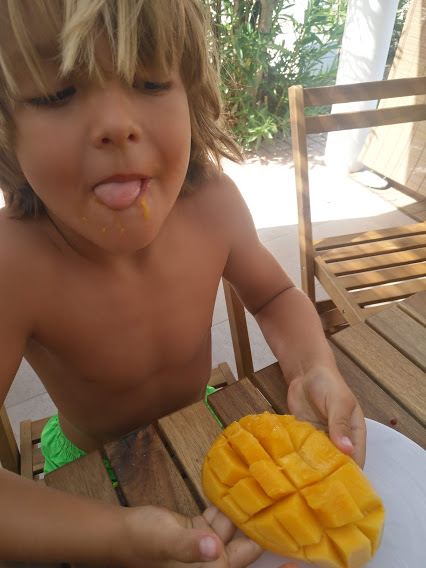 Veneguera. Really fresh ones have a faint white bloom on the skin, like a fine layer of chalk dust.
Veneguera. Really fresh ones have a faint white bloom on the skin, like a fine layer of chalk dust.
If you find a mango that smells great, it will taste just as good no matter what it looks like.The tiny yellow ones, often with sticky skin, are fibrous inside but taste delicious. Larger yellow or green ones have no fibres and you can smell them as soon as you walk into the shop.
Some varieties, like the big red ones, are delicious but don't have any odour at all. Choose one that is slightly soft to the touch but doesn't have black spots or by the stem (which indicate that it has started to rot before it ripens).
It's often best to buy local fruit in Gran Canaria from small shops and fruterias rather than the big supermarkets. The supply chain is shorter and the fruit less likely to be picked early and kept in cold storage.
Go Green In Firgas: Watercress And The Growing Call To Free The Water
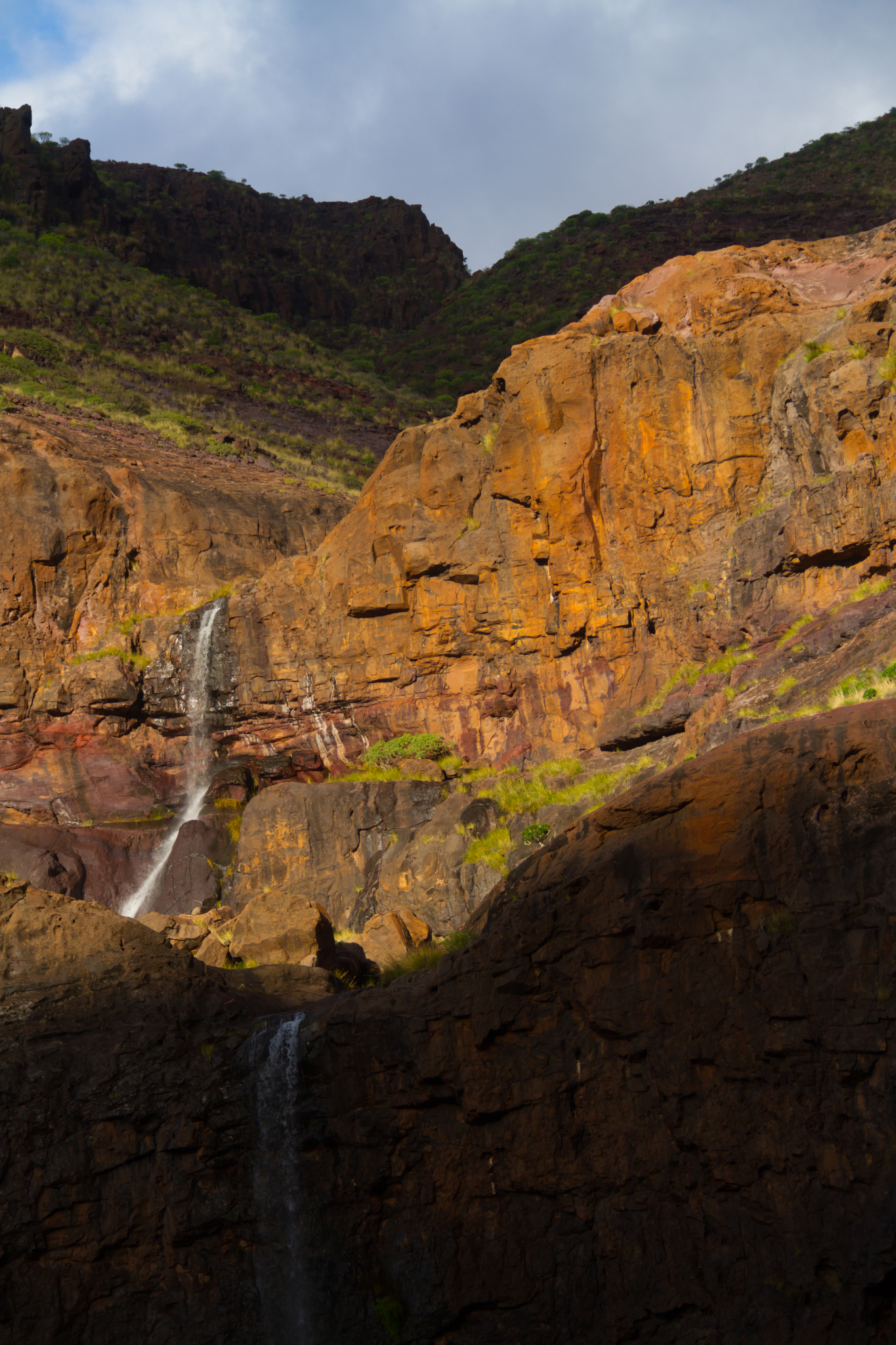 As you drive or walk around Gran Canaria you get the impresssion that it's a dry island because there is no water flowing in the valleys. However, this is an illusion as almost every barranco on the island should have a natural stream.
As you drive or walk around Gran Canaria you get the impresssion that it's a dry island because there is no water flowing in the valleys. However, this is an illusion as almost every barranco on the island should have a natural stream.
Before tourism, water was life in Gran Canaria. Vast networks of water channels carried it from natural springs and deep galleries carved into the island to where it was needed for drinking, washing clothes and watering crops. These stone waterways and aqueducts were built to last for centuries and managed communaly by the people they supplied. The washing points were meeting points for local commmunites and the flowing water kept valleys cool and allowed the island's birds to drink. The water was chanelled but still leaked out to keep palm groves watered.
 Nowadays most of the water runs through undergound pipes. The old water-sharing agreements have disappeared to be replaced with commercial contracts. Water no longer flows free and a shocking amount goes to irrigating unprofitable banana plantations that only make money thanks to huge subsidies.
Nowadays most of the water runs through undergound pipes. The old water-sharing agreements have disappeared to be replaced with commercial contracts. Water no longer flows free and a shocking amount goes to irrigating unprofitable banana plantations that only make money thanks to huge subsidies.
Palm trees all over the island, such as the Agaete Valley and Telde, have died in their hundreds and there are no streams to act as natural firebreaks during the summer.
Free the water: A common resource and vital for tourism
A growing number of local people are calling for change. Why does the island's water flow out of view? Why do a few people get to decide what it is used for? Why don't we put it back where it belongs; running free down the island's barrancos? Why do we spend a fortune keeping a few farmers in business when the money co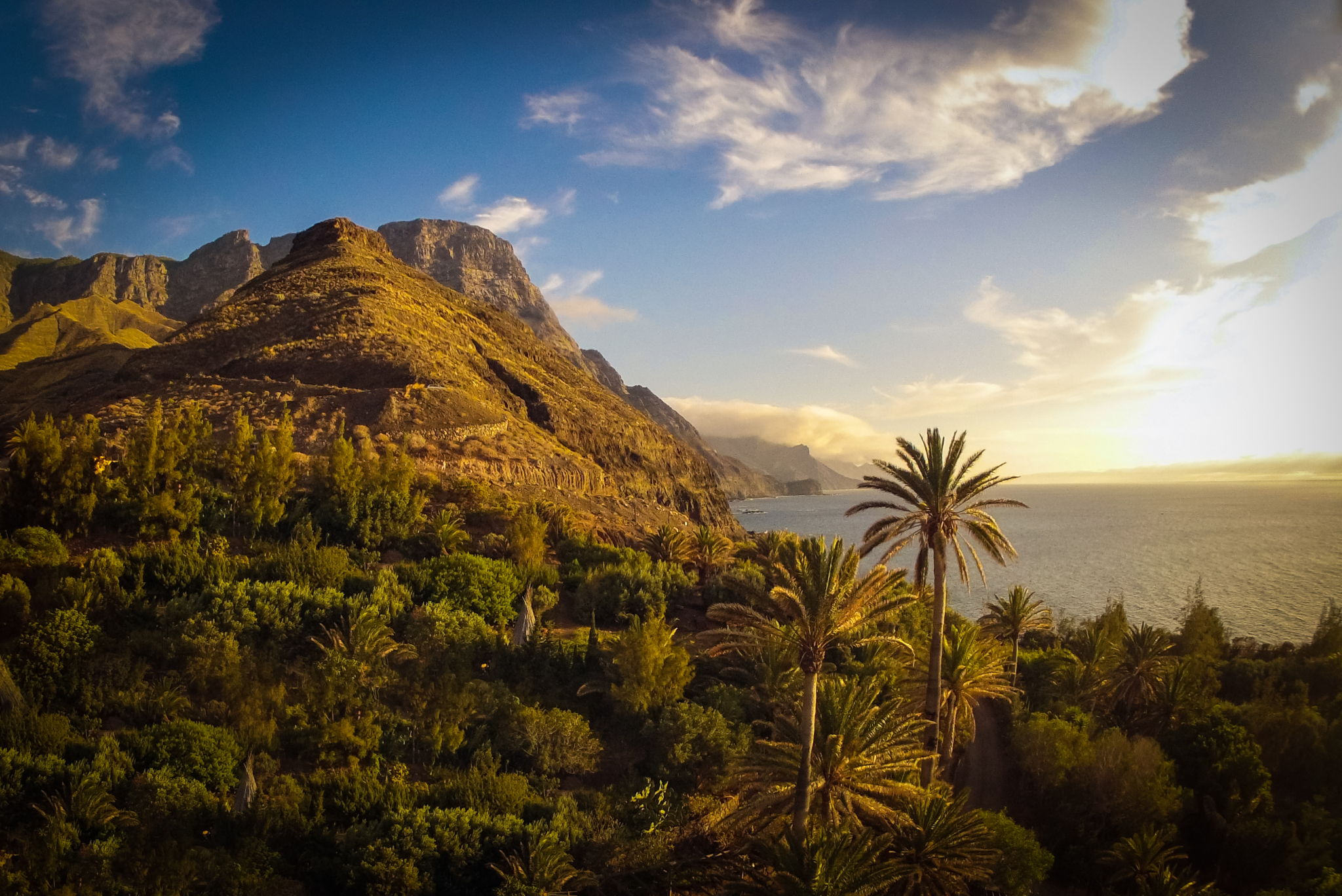 uld be spend on rewilding the island, replanting its forests and making Gran Canaria a more attractive place to live and to visit?
uld be spend on rewilding the island, replanting its forests and making Gran Canaria a more attractive place to live and to visit?
If Gran Canaria wants to be a more attractive place for walkers and visitors, putting the water back would be a good start. You only have to look at the popularity of the few places where free-flowing water remains; Azuaje, Barranco de los Cernicalos, Barranco de la Virgen up by Fontanales, and the water town of Firgas.
Firgas: Gran Canaria's water town
 Firgas is the place in Gran Canaria that most visitors associate with water. The islands eponymous mineral water is bottled nearby and the main street in town has a flowing water feature. The old part of town is dotted with restored water mills, aqueducts and water channels.
Firgas is the place in Gran Canaria that most visitors associate with water. The islands eponymous mineral water is bottled nearby and the main street in town has a flowing water feature. The old part of town is dotted with restored water mills, aqueducts and water channels.
In the surrounding countryside, the main crop isn't bananas but watercress or berros, essential ingredient of one of Gran Canaria's most famous dishes; potaje de berros.
And where better to try it that in Firgas itself?
Any restaurant in or around town will serve you up a bowl of watercress, maize and pork soup, often sprinkled with gofio (toasted maize flour).
But one restaurant has upped its berros game beyond just potaje...
El Rincón de Marcos goes all in on the green stuff
El Rincón de Marcos, five minutes walk southwest of the Firgas church, puts watercress into everything. Green, pepperry bread, cress croquettes, green alioli, salads loaded with watercress, watercress soup, even a flan (creme caramel) with a greenish hue for dessert.
The potaje de berros, alioli and croquettas are excellent, as is the bread. The dessert and a couple of other green dishes are more about the novelty than anything else (does anyone re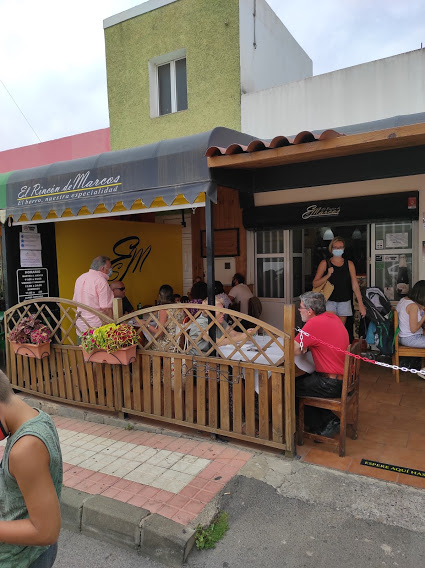 ally need a green flan?). It also serves plenty of non-watercress options like steak, calamares and papas arrugadas.
ally need a green flan?). It also serves plenty of non-watercress options like steak, calamares and papas arrugadas.
The restaurant itself is rustic with an outdoor terrace for warm days and cosy indoor rooms for the inevitable wet days. There's a reason why Firgas is famous for water; it's one of the island's rainiest spots.
Book el Rincón de Marcos if you plan to visit Firgas at the weekend but you should be fine just walking in on weekdays, especially if you turn up early (before 14.00).
1
Firgas town in north Gran Canaria is famous for water. The island's eponymous mineral water is bottled nearby, the main street has a waterfall, and the old part of town is dotted with restored mills and aqueducts.
Gran Canaria Info: Our Reliable Airport Transfer Service
Gran Canaria Info has teamed up with a quality local transport company to offer you a safe and reliable transfer service from Gran Canaria airport direct to your accommodation.
The service lets you skip the airport taxi queues, save money, and travel direct to your accommodation with no delays or hidden charges. The quality of this service is guaranteed by Gran Canaria Info; the island's top source of quality local information.
The Gran Canaria Info airport transfer service includes the following...
- Greeting at the arrival gate by your driver
- Transfer to your accommodation in a quality, fully insured car by a licensed, multilingual driver
- Payment on arrival apart from the booking deposit of 20%
The prices of the Gran Canaria Info airport transfer service for up to 3 people* in euros are as follows...
- Airport - Playa del Ingles 40. Return 75
- Airport - Meloneras / Pasito Blanco 45. Return 85
- Airport - Puerto Rico 50. Return 90
- Airport - Mogan 60. Return 100
*Covid rules limit the number of passengers in a standard taxi or private transfer vehicle to three.
For larger groups of four to six people, with transport in a Mercedes van, the prices are as follows...
- Airport - Playa del Ingles 50. Return 100
- Airport - Meloneras / Pasito Blanco 55. Return 100
- Airport - Puerto Rico 60. Return 110
- Airport - Mogan 70. Return 120
For even larger groups (more than 6 persons), please send us a message, or contact our booking team via this WhatsApp form. Thank you!
To book a Gran Canaria airport transfer just fill in this form, leave a small deposit and you will receive a confirmation form right away. Our transfer service will then be in touch to arrange the details of where you will be met, etc. Any questions or problems, just let us know and well sort them out right away.
Covid, Migration, Masks, etc: The GCI Position On All Of It
This is a personal message from Lex and Alex at Gran Canaria Info.
It has been a loooong year since the first lockdown and the collapse of tourism here in the Canary Islands. During this period we have done our best to provide accurate and useful information about a wide range of subjects; travel restrictions, Covid rules, mask use, migrants, more migrants, etc. We feel like we have done a good job overall and we hope the majority of you do too.
However, we also know that we have, at different times, annoyed a lot of people. Many of them haven't been shy about telling exactly why and most of the time we appreciated the communication and honesty. We did remove a small number of people from the group and from the page for consistently being rude to us and/ or other members, and for sharing fringe beliefs such as "Covid doesn't exist", "you are all sheeple", "the chemtrails did it", "migrants should be thrown in the sea", etc. Life is just too short!
2020: Fun, fun, fun in the sun
Back during the first lockdown we warned that Covid was going to take at least a year to sort out (based on official government estimates and the scienfitic consensus on vaccine development) and were heavily criticised for being negative. Unfortunately, we were right and even now in April of 2021, tourism is still at very low levels and even the optimists don't expect summer numbers to be above 50% of pre-Covid figures.
We also covered the ever-changing mask, distancing and travel rules imposed by the Canary Islands, Spain and other countries in as much detail as we could. We were shouted at for encouraging people to follow "the stupid rules" and shouted at for not being strident enough about getting people to follow them. We have been frustrated at times by the many rule changes and by the need to wear masks at all times outdoors. However, we have also seen that there has been very little conflict here between the people and the police because of the simple mask rules.
We also got the standard Brexit outrage from people at both ends of the argument. We were either too pro-Europe or too anti-Britain, or too pro-Britain and anti-Europe. For the record, as foreign residents living in Spain, we believe that the EU is a good idea despite its flaws.
As for vaccines, we are in favour. We plan to be in the queue for ours with a bag of ice and a bottle of rum as soon as possible (even Lex, who very likely had Covid back in February 2020). Not everyone agrees with us about this either.
We have allowed plenty of debate in the Gran Canaria Info group but it really isn't the place for endless arguments so we have also deleted a lot of posts.
It is our deeply-held belief that there is no grown-up or friendly way of calling us or anyone else in the group "sheeple".
Then the migrants hit the headlines and all hell broke loose...
As we said, fun, fun, fun in the sun!
Gran Canaria and the 'migrant crisis' of 2020
Migrants have arrived on Gran Canaria's shores in small boats for 25 years but they only became a story in 2020 due to Covid and messy Spanish politics.
Our position was and still is that the people arriving in Gran Canaria should be treated with dignity and allowed to continue on their journey as soon as possible. Almost all of them come with the dream of working to provide for their families back at home. None of the migrants arriving in the Canary Islands want to stay here. They all have a destination in mind somewhere in mainland Europe. Many have borrowed money from family and friends to get to the islands and feel huge pressure to move on and start earning.
To give a bit of context to this, here is a single statistic; those lucky enough to work in one of Senegal's fish processing factories make the equivalent of one dollar per day.
Whatever your politics and beliefs about migration, the migrant's interests and the interests of the Canary Islands are pretty much the same. It is in all of our best interests for them to be allowed to continue to migrate from the Islands to mainland Spain and Europe. Why? Because as we saw this autumn, the Canary Islands do not have, and shouldn't need to have, the facilities to house thousands of people. Spain and Europe both have agreements in place to process and house migrants. and while Covid did make things harder, the only reason these agreements didn't work was due to politics. As one Spanish minister said, the Canary Islands were used "like a cork in the bottle" to stop migrants reaching Spain.
To us, this idea that treating people badly stops them dreaming is absurd.
Almost all migrants have now been moved out of Gran Canaria's resorts and there isn't any reason why the islands will need to house migrants in resort areas again. Even at the peak of the wave almost all the migrants housed in resort areas behaved well despite the lurid press reports in Europe's tabloid press.
That said, we do aknowledge that many people living in areas like Puerto Rico experienced serious disruption from migrants housed in empty complexes. There were serious crimes, including a rape, committed by migrants and the noise and disturbance in some areas was considerable and constant.
But the theory that the migrants have caused Gran Canaria's resorts to be empty, or will cause them to be empty in the future is pretty thin. Gran Canaria's resorts are empty due to Covid, not the migrants. And once Covid travel restrictions end, tourists coming back will find Gran Canaria is the same as always (better in the case of Puerto Rico thanks to the new malls and the refurbished main shopping centre).
We make no apology for our position about the migrants. The fact that the islands have handled the migrants with dignity and respect is to our credit. We believe that the vast majority of people who want to come back to Gran Canaria will understand that the islands dealt with a difficult situation pretty well.
We hope to see you all on the beach again very soon.
Lex and Alex
We have
Gran Canaria Info recommends:
- Default
- Title
- Date
- Random






















